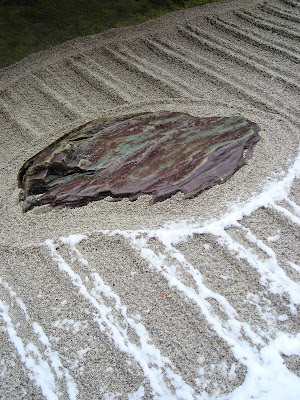1st October 2010
At the Nishijin Textile Center in Kyoto, kimono fashion shows are held a number of times a day, almost every day of the year. The photos below were taken at one show.

Worn traditionally, a kimono has no buttons, clasps, zips or velcro. Everything is held together by fabric or cords: the wide obi belt, the obijime cord over it, the obiage sash that rides at the top of the obi and holds it up, and the unseen koshihimo sashes under all of them. (A koshihimo is used to create the fold at the hips - a feature not seen when males wear kimono.)

The little flowers in the back - the only adornment on this kimono - play off the roses in the obi.

The furisode - which can be translated as swinging sleeves - has the longest sleeves of all the kinds of kimono. It is worn by girls and young single women on formal occasions such as Coming of Age Day and the first shrine visit of the year.

Another furisode, less formal-looking than the one above. Note how the model brings one foot in front of the other rather than walking with feet set in the usual hip width.

A sheer kimono for the warmer months. The obi has a design of Heian aristocrats. The slight bulge at the top of the obi is due to the obi makura - a little pillow slipped into the fold to support and give shape to the obi. The makura is tied on, just like everything else.
An obi can be luxurious...

...or subtle.

The otaiko musubi - drum knot - is probably the most common way to tie a woman's obi. Here are two variations:


The obi age - the sash above the obi - is yet another indicator of the wearer's marital status. In a young unmarried woman's ensemble, more of the obi age is allowed to show (see furisode pictures above). Below, the sash is tucked discreetly into the obi, revealing just enough to accent the green at the ends of the sleeves, in the obi and in the lining of the kimono.

The subtle circles in the kimono fabric below are a theme picked up and developed by the riceball design of the obi. A well-considered kimono ensemble offers a wealth of details to be decoded and enjoyed.

Flowers - organic handbags.

No comments:
Post a Comment